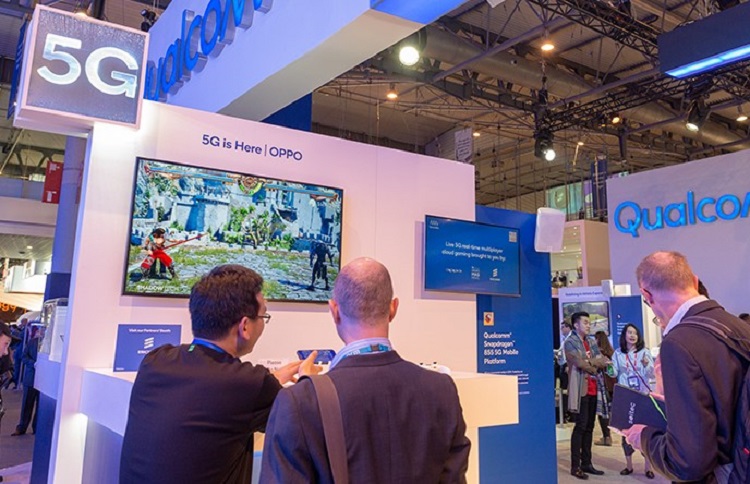How 5G changes gaming technology

Thanks to the collaboration of companies in the industry, new devices are already entering the market and 5G networks and infrastructure are being actively deployed. After ten years of developing the revolutionary technologies needed to create new-generation networks, we have introduced the Qualcomm Snapdragon 855 mobile platform to the world, the first commercial platform supporting the 5G multi-gigabit network coupled with the Snapdragon X55 modem. And quite soon real 5G gadgets will be on sale!
In this article we want to talk about the new features that 5G era is capable of giving people. And these features, including those that we have already talked about, are getting closer to users. Let's talk today about what the arrival of the 5G era means for games and communications.
Game evolution
The popularity of mobile games is growing . In 2017, they played 2.1 billion people, but it is expected that by 2021 this figure will increase to 2.7 billion.
')
The main obstacle to a smooth gameplay - the delay in data transmission, or "lag". The speed of reaction in games is very important, so even a minimal lag can lead to the fact that you miss the enemy in a shooter or skip the desired turn in a racing simulator. Also a high level of delay prevents to achieve full immersion in the game. This indicator is so important that many developers have begun to add a special scale to the interface of their games, which shows the quality of the connection to the network.
The focus of the igroproma is gradually shifting towards the “cloud”, which was confirmed by a new announcement by Google, which a few weeks ago presented its own cloud-based gaming service, Stadia, at San Francisco at GDC. And there it became clear that reducing the latency in data transmission becomes an even more important task. Another example would be the Qualcomm booth at MWC Barcelona , where One Plus and OPPO gave visitors a chance to appreciate the possibilities of cloud-based gaming by playing the multiplayer modes Ace Combat 7 and Soul Calibur VI. And all the game data was transmitted from the "cloud" in streaming mode over the 5G network.

5G allows developers to cope with the problem of delay and gives them and users a completely new opportunity. We believe that the very concept of “lag” in games will soon be forgotten with the technologies of networks of the fifth generation, and the combination of 5G and augmented reality in multiplayer mobile AR-games will help bring mobile gaming to a whole new level.
Using only smartphones, you and your friends will be able to play paintball in augmented reality to combine the real world with elements of the virtual. As in the real paintball battle, when you need to run around the playground and shoot paintballs at your friends, you will catch them in the “sight” of your smartphone and tap the screen to fire at digital paintball shells. In addition to reducing latency, 5G technology and artificial intelligence will help ensure complete immersion in the game with high-quality graphics and new effects. For example, if a virtual projectile gets into the clothes of a friend of such a virtual projectile, the ball will not just bounce off it, as in 4G games, it will make the fabric at the point of impact bend, and then in real time it will fill it with bright color.
Evolution of communications
Text messages, social networks and video chats - now there is an almost infinite number of ways for comfortable virtual communication, but many of them are associated with certain problems. Part of the technology depends heavily on delays in data transmission, and when communicating with residents of other countries, the language barrier prevents much more than the distance between the interlocutors. Real-time speech translation technologies already exist, but they also have their limitations, the main one of which again is the delay in data transmission. Extremely low latency on 5G networks will help solve these problems and give people reliable and high-speed communications to communicate.
We believe that thanks to the combination of 5G networks and artificial intelligence in the era of the Wireless Edge transformation, people will be able to overcome language barriers and communicate via video link with anyone, anywhere, without delay and lag, regardless of the language of communication and the location of interlocutors. At the same time, artificial intelligence technologies are gradually moving from networks directly to modern devices with powerful processors. This will ensure the work of an instant and “smart” translator for such communication.
For example, the face mapping technology, which reads face parameters and synchronizes lip movement during a conversation, can be further enhanced by the effect of these translators, so that the interlocutor can not only hear but also “see” how you speak his language. Friends and family members separated by distance will become closer again, and working with representatives of other nationalities will become much easier and more comfortable.
The possible uses of the 5G technologies described in our articles will help us communicate and interact at a completely new level, but they are only a small fraction of the capabilities of 5G. 5G networks open doors for completely new application scenarios that people haven’t even thought about yet. And this concerns not only smartphones.
The world of 5G will be full of industries that completely change the Internet of things, including, for example, vehicles and manufacturing. Both our technologies and our life will only benefit from this and become even smarter!
Source: https://habr.com/ru/post/449680/
All Articles